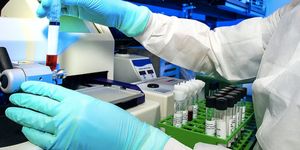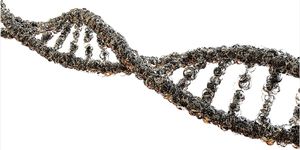Sulfur May've Been Essential to the Evolution of Multicellular Life
We've heard a lot about how important carbon and water are to life, but sulfur? Researchers think that sulfur may have actually been essential for organisms to make the transition from single-celled to multicellular life. It's estimated that about one billion years after Earth formed, single-celled organisms evolved. Multi-cellular organisms, however, aren't thought to have arisen until about 600 million years ago. The details of the transition from unicellular to multicellular life are unclear.
Researchers in the lab of Erika Pearce at the MPI of Immunobiology and Epigenetics have investigated how changes in metabolism can alter the function and growth of cells. They once used immune cells in their work. But the slime mold Dictyostelium discoideum is able to live as both unicellular and multicellular organisms. The switch between these states in slime mold depends on food availability.
"We figured that if we were interested in how nutrient availability induces changes in how cells function, there was no better organism to study than Dicty [Dictyostelium discoideum], where starvation causes cells to go from existing on their own to forming a multicellular organism. This is an immense shift in biology," Pearce said. They thought that this mold could also tell us more about the evolution from unicellular to multicellular life.
Reporting in Nature, when the researchers deprived 'Dicty' of food, they turned it from lone cells to aggregates that were made up of multiple cells. These aggregates act like a complex organism, and have specialized cells with different functions; these multi-celled aggregates also move as one. Eventually, a multicellular Dicty will generate a protective spore, and this whole will survive starvation.
If Dicty starves, it rapidly releases a burst of reactive oxygen species (ROS), which can normally send signals from one cell to another but also become damaging at high levels. Antioxidant production gets ramped up when ROS levels are raised, keeping the ROS under control. In the slime mold, glutathione can act as that controlling antioxidant, and it also keeps the mold in unicellular form.
"In our case, production of the antioxidant glutathione increased to counter the massive ROS burst upon starvation. If we gave the starving slime mold extra glutathione, we were able to block this increase in ROS and, importantly, stop the formation of the multicellular aggregate, keeping the cells in a single-celled state," explained first study author Beth Kelly.
Glutathione is made of three amino acids, cysteine, glycine, and glutamine. And when the researchers exposed the starving mold cells to each one of those amino acids individually, cysteine alone could reverse aggregation when Dicty was starved. The unique thing about cysteine is sulfur, which is crucial for a variety of cellular functions, including supporting the production of energy.
If cysteine is limited, so is the sulfur supply. Cells grow more slowly, which suggests that they don't have enough nutrients or energy to continue. For Dicty, that means transitioning to a multicellular state so it will form a spore that is capable of surviving starvation and preserving the population. When it's starving, Dicty can increase ROS, which increases glutathione production.
"This in effect pulls cysteine in the cells into glutathione, limiting the use of its sulfur for proliferation and protein production. By artificially blocking glutathione production, or by providing extra cysteine to the starving cells, we could restore this sulfur supply, recovering proliferation and the single-celled state," Kelly said. "Thus, we revealed how sulfur dictates a switch between the single-celled and multicellular states." In the ancient world, sulfur and oxygen were probably common, and may have played a crucial role in the evolution of multicellularity.
"Beyond this, we think that our work has therapeutic implications for more complex organisms. Cancer cells are highly proliferative, and some cancer cells specifically preserve sulfur metabolism. Restricting or targeting sulfur metabolic processes in these cells may enhance anti-tumor immunity," Pearce said.
Sources: Phys.org via Max Planck Institute (MPI) of Immunobiology and Epigenetics, Nature









